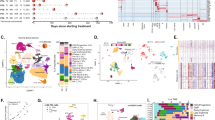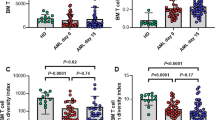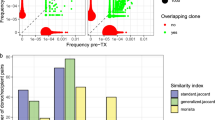Abstract
Allogeneic stem cell transplantation (alloSCT) is used for treating patients with T-prolymphocytic leukemia (T-PLL). However, direct evidence of GvL activity in T-PLL is lacking. We correlated minimal residual disease (MRD) kinetics with immune interventions and T-cell receptor (TCR) repertoire diversity alterations in patients after alloSCT for T-PLL. Longitudinal quantitative MRD monitoring was performed by clone-specific real-time PCR of TCR rearrangements (n=7), and TCR repertoire diversity assessment by next-generation sequencing (NGS; n=3) Although post-transplant immunomodulation (immunosuppression tapering or donor lymphocyte infusions) resulted in significant reduction (>1 log) of MRD levels in 7 of 10 occasions, durable MRD clearance was observed in only two patients. In all three patients analyzed by TCR-NGS, MRD responses were reproducibly associated with a shift from a clonal, T-PLL-driven profile to a polyclonal signature. Novel clonotypes that could explain a clonal GvL effect did not emerge. In conclusion, TCR-based MRD quantification appears to be a suitable tool for monitoring and guiding treatment interventions in T-PLL. The MRD responses to immune modulation observed here provide first molecular evidence for GvL activity in T-PLL which, however, may be often only transient and reliant on a poly-/oligoclonal rather than a monoclonal T-cell response.
This is a preview of subscription content, access via your institution
Access options
Subscribe to this journal
Receive 12 print issues and online access
$259.00 per year
only $21.58 per issue
Buy this article
- Purchase on Springer Link
- Instant access to full article PDF
Prices may be subject to local taxes which are calculated during checkout



Similar content being viewed by others
Change history
05 April 2017
This article has been corrected since Advance Online Publication and a corrigendum is also printed in this issue.
References
Dearden C . How I treat prolymphocytic leukemia. Blood 2012; 120: 538–551.
Guillaume T, Beguin Y, Tabrizi R, Nguyen S, Blaise D, Deconinck E et al. Allogeneic hematopoietic stem cell transplantation for T-prolymphocytic leukemia: a report from the French society for stem cell transplantation (SFGM-TC). Eur J Haematol 2015; 94: 265–269.
Kalaycio ME, Kukreja M, Woolfrey AE, Szer J, Cortes J, Maziarz RT et al. Allogeneic hematopoietic cell transplant for prolymphocytic leukemia. Biol Blood Marrow Transplant 2010; 16: 543–547.
Krishnan B, Else M, Tjonnfjord GE, Cazin B, Carney D, Carter J et al. Stem cell transplantation after alemtuzumab in T-cell prolymphocytic leukaemia results in longer survival than after alemtuzumab alone: a multicentre retrospective study. Br J Haematol 2010; 149: 907–910.
Wiktor-Jedrzejczak W, Dearden C, de Wreede L, van Biezen A, Brinch L, Leblond V et al. Hematopoietic stem cell transplantation in T-prolymphocytic leukemia: a retrospective study from the European Group for Blood and Marrow Transplantation and the Royal Marsden Consortium. Leukemia 2012; 26: 972–976.
de Lavallade H, Faucher C, Furst S, El-Cheikh J, Vey N, Coso D et al. Allogeneic stem cell transplantation after reduced-intensity conditioning in a patient with T-cell prolymphocytic leukemia: graft-versus-tumor effect and long-term remission. Bone Marrow Transplant 2006; 37: 709–710.
Dreger P, Dohner H, Ritgen M, Bottcher S, Busch R, Dietrich S et al. Allogeneic stem cell transplantation provides durable disease control in poor-risk chronic lymphocytic leukemia: long-term clinical and MRD results of the German CLL Study Group CLL3X trial. Blood 2010; 116: 2438–2447.
Farina L, Carniti C, Dodero A, Vendramin A, Raganato A, Spina F et al. Qualitative and quantitative polymerase chain reaction monitoring of minimal residual disease in relapsed chronic lymphocytic leukemia: early assessment can predict long-term outcome after reduced intensity allogeneic transplantation. Haematologica 2009; 94: 654–662.
Hahn M, Bottcher S, Dietrich S, Hegenbart U, Rieger M, Stadtherr P et al. Allogeneic hematopoietic stem cell transplantation for poor-risk CLL: dissecting immune-modulating strategies for disease eradication and treatment of relapse. Bone Marrow Transplant 2015; 50: 12–79-1285.
Moreno C, Villamor N, Colomer D, Esteve J, Gine E, Muntanola A et al. Clinical significance of minimal residual disease, as assessed by different techniques, after stem cell transplantation for chronic lymphocytic leukemia. Blood 2006; 107: 4563–4569.
Ritgen M, Bottcher S, Stilgenbauer S, Bunjes D, Schubert J, Cohen S et al. Quantitative MRD monitoring identifies distinct GVL response patterns after allogeneic stem cell transplantation for chronic lymphocytic leukemia: results from the GCLLSG CLL3X trial. Leukemia 2008; 22: 1377–1386.
Brüggemann M, White H, Gaulard P, Garcia-Sanz R, Gameiro P, Oeschger S et al. Powerful strategy for polymerase chain reaction-based clonality assessment in T-cell malignancies Report of the BIOMED-2 Concerted Action BHM4 CT98-3936. Leukemia 2007; 21: 215–221.
Chapman M, Warren EH 3rd, Wu CJ . Applications of next-generation sequencing to blood and marrow transplantation. Biol Blood Marrow Transplant 2012; 18: S151–S160.
Freeman JD, Warren RL, Webb JR, Nelson BH, Holt RA . Profiling the T-cell receptor beta-chain repertoire by massively parallel sequencing. Genome Res 2009; 19: 1817–1824.
Weng WK, Armstrong R, Arai S, Desmarais C, Hoppe R, Kim YH . Minimal residual disease monitoring with high-throughput sequencing of T cell receptors in cutaneous T cell lymphoma. Sci Transl Med 2013; 5: 214ra171.
Brüggemann M, van der Velden VH, Raff T, Droese J, Ritgen M, Pott C et al. Rearranged T-cell receptor beta genes represent powerful targets for quantification of minimal residual disease in childhood and adult T-cell acute lymphoblastic leukemia. Leukemia 2004; 18: 709–719.
van der Velden VH, Wijkhuijs JM, Jacobs DC, van Wering ER, van Dongen JJ . T cell receptor gamma gene rearrangements as targets for detection of minimal residual disease in acute lymphoblastic leukemia by real-time quantitative PCR analysis. Leukemia 2002; 16: 1372–1380.
van der Velden VH, Cazzaniga G, Schrauder A, Hancock J, Bader P, Panzer-Grumayer ER et al. Analysis of minimal residual disease by Ig/TCR gene rearrangements: guidelines for interpretation of real-time quantitative PCR data. Leukemia 2007; 21: 604–611.
van Dongen JJ, Langerak AW, Brüggemann M, Evans PA, Hummel M, Lavender FL et al. Design and standardization of PCR primers and protocols for detection of clonal immunoglobulin and T-cell receptor gene recombinations in suspect lymphoproliferations: report of the BIOMED-2 Concerted Action BMH4-CT98-3936. Leukemia 2003; 17: 2257–2317.
Lefranc MP, Giudicelli V, Duroux P, Jabado-Michaloud J, Folch G, Aouinti S et al. IMGT(R), the international ImMunoGeneTics information system(R) 25 years on. Nucleic Acids Res 2015; 43: D413–D422.
Bassan R, Spinelli O, Oldani E, Intermesoli T, Tosi M, Peruta B et al. Improved risk classification for risk-specific therapy based on the molecular study of minimal residual disease (MRD) in adult acute lymphoblastic leukemia (ALL). Blood 2009; 113: 4153–4162.
Brüggemann M, Raff T, Flohr T, Gokbuget N, Nakao M, Droese J et al. Clinical significance of minimal residual disease quantification in adult patients with standard-risk acute lymphoblastic leukemia. Blood 2006; 107: 1116–1123.
Gökbuget N, Kneba M, Raff T, Trautmann H, Bartram CR, Arnold R et al. Adult patients with acute lymphoblastic leukemia and molecular failure display a poor prognosis and are candidates for stem cell transplantation and targeted therapies. Blood 2012; 120: 1868–1876.
Patel B, Rai L, Buck G, Richards SM, Mortuza Y, Mitchell W et al. Minimal residual disease is a significant predictor of treatment failure in non T-lineage adult acute lymphoblastic leukaemia: final results of the international trial UKALL XII/ECOG2993. Br J Haematol 2010; 148: 80–89.
Raff T, Gökbuget N, Lüschen S, Reutzel R, Ritgen M, Irmer S et al. Molecular relapse in adult standard-risk ALL patients detected by prospective MRD monitoring during and after maintenance treatment: data from the GMALL 06/99 and 07/03 trials. Blood 2007; 109: 910–915.
Logan AC, Vashi N, Faham M, Carlton V, Kong K, Buno I et al. Immunoglobulin and T cell receptor gene high-throughput sequencing quantifies minimal residual disease in acute lymphoblastic leukemia and predicts post-transplantation relapse and survival. Biol Blood Marrow Transplant 2014; 20: 1307–1313.
Wu D, Sherwood A, Fromm JR, Winter SS, Dunsmore KP, Loh ML et al. High-throughput sequencing detects minimal residual disease in acute T lymphoblastic leukemia. Sci Transl Med 2012; 4: 134ra63.
Logan AC, Gao H, Wang C, Sahaf B, Jones CD, Marshall EL et al. High-throughput VDJ sequencing for quantification of minimal residual disease in chronic lymphocytic leukemia and immune reconstitution assessment. Proc Natl Acad Sci USA 2011; 108: 21194–21199.
Logan AC, Zhang B, Narasimhan B, Carlton V, Zheng J, Moorhead M et al. Minimal residual disease quantification using consensus primers and high-throughput IGH sequencing predicts post-transplant relapse in chronic lymphocytic leukemia. Leukemia 2013; 27: 1659–1665.
Meier J, Roberts C, Avent K, Hazlett A, Berrie J, Payne K et al. Fractal organization of the human T cell repertoire in health and after stem cell transplantation. Biol Blood Marrow Transplant 2013; 19: 366–377.
van Heijst JW, Ceberio I, Lipuma LB, Samilo DW, Wasilewski GD, Gonzales AM et al. Quantitative assessment of T cell repertoire recovery after hematopoietic stem cell transplantation. Nat Med 2013; 19: 372–377.
Yew PY, Alachkar H, Yamaguchi R, Kiyotani K, Fang H, Yap KL et al. Quantitative characterization of T-cell repertoire in allogeneic hematopoietic stem cell transplant recipients. Bone Marrow Transplant 2015; 50: 1227–1234.
Acknowledgements
We thank all our patients for their kind willingness to contribute clinical data and biological samples to make this study possible. TR, AK, VB, ND funded by CEITEC MU (CZ.1.05/1.1.00/02.0068) and EuroClonality, with computational resources provided by MetaCentrum under program LM2010005, and CERIT-SC under program Centre CERIT Scientific Cloud, part of the Operational Program Research and Development for Innovations, CZ.1.05/3.2.00/08.0144.
Author information
Authors and Affiliations
Corresponding author
Ethics declarations
Competing interests
The authors declare no conflict of interest.
Additional information
Presented in part in abstract form at the 57th Annual Meeting of the American Society of Hematology (ASH; December 5–8, 2015, Orlando, FL, USA) and the 42nd Annual Meeting of the European Society for Blood and Marrow Transplantation (EBMT; April 3–6, 2016, Valencia, Spain).
Supplementary Information accompanies this paper on Bone Marrow Transplantation website
Supplementary information
Rights and permissions
About this article
Cite this article
Sellner, L., Brüggemann, M., Schlitt, M. et al. GvL effects in T-prolymphocytic leukemia: evidence from MRD kinetics and TCR repertoire analyses. Bone Marrow Transplant 52, 544–551 (2017). https://doi.org/10.1038/bmt.2016.305
Received:
Revised:
Accepted:
Published:
Issue Date:
DOI: https://doi.org/10.1038/bmt.2016.305
This article is cited by
-
Advances and Perspectives in the Treatment of T-PLL
Current Hematologic Malignancy Reports (2020)
-
Effect of allogeneic hematopoietic cell transplantation for patients with T-prolymphocytic leukemia: a retrospective study from the Adult Lymphoma Working Group of the Japan Society for hematopoietic cell transplantation
Annals of Hematology (2019)
-
EBMT prospective observational study on allogeneic hematopoietic stem cell transplantation in T-prolymphocytic leukemia (T-PLL)
Bone Marrow Transplantation (2019)
-
Is Next-Generation Sequencing the way to go for Residual Disease Monitoring in Acute Lymphoblastic Leukemia?
Molecular Diagnosis & Therapy (2017)



